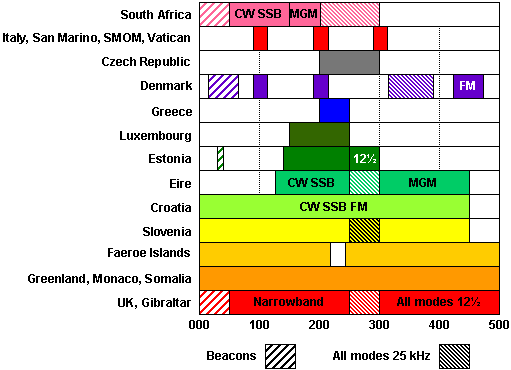4 metres
Related wiki pages Bands, Propagation
| Band: 4m | |
| Bands | |
| 160m 80m 60m 40m 30m 20m 17m 15m 12m 10m 6m 4m 2m 1.25m 70cm 33cm 23cm 3cm | |
| Band Privileges | |
| US Extra | None |
| US Advanced | None |
| US General | None |
| US Technician | None |
| UK (all) | 70-70.5 |
The amateur 4 metre band is located just above 70 MHz.
As 66-72 MHz is VHF TV channel 4 in NTSC-M countries, this band is not available in Canada, the US, México or South Korea.
Equipment
The 4 metre band is available to amateurs in certain countries in Region 1, but is not available in the United States, Japan or Australia. This makes manufactured radio equipment for the band very rare. Most amateurs use homebrew or modified gear to operate on 4 metres.
Different countries have different 4 metre band edges, as shown in this band chart.
Modulation
CW and voice are permitted (see chart for specific local allocations). The band is too small for fast-scan ATV, which can only be accommodated on UHF or higher.
Propagation
VHF typically provides slightly better than line-of-sight propagation, although rare conditions (such as inversion or sporadic E-skip) may greatly increase this distance for a very short (and unpredictable) interval.
Additional Information
A good source of information is the Four Metres Website.
Band plan for 4 metres
| Bands | |
| HF and MF | 160 metres * 80 metres* 60 metres * 40 metres * 30 metres * 20 metres * 17 metres * 15 metres * 12 metres * 10 metres |
| VHF | 6 metres * 4 metres * 2 metres * 1.25 metres |
| UHF | 70 centimetres * 33 centimetres * 23 centimetres * 13 centimetres |
| Microwave | 9 centimetres * 6 centimetres * 3 centimetres * 1.25 centimetres * Bands above 24GHz |
| See also | US bandplan |
